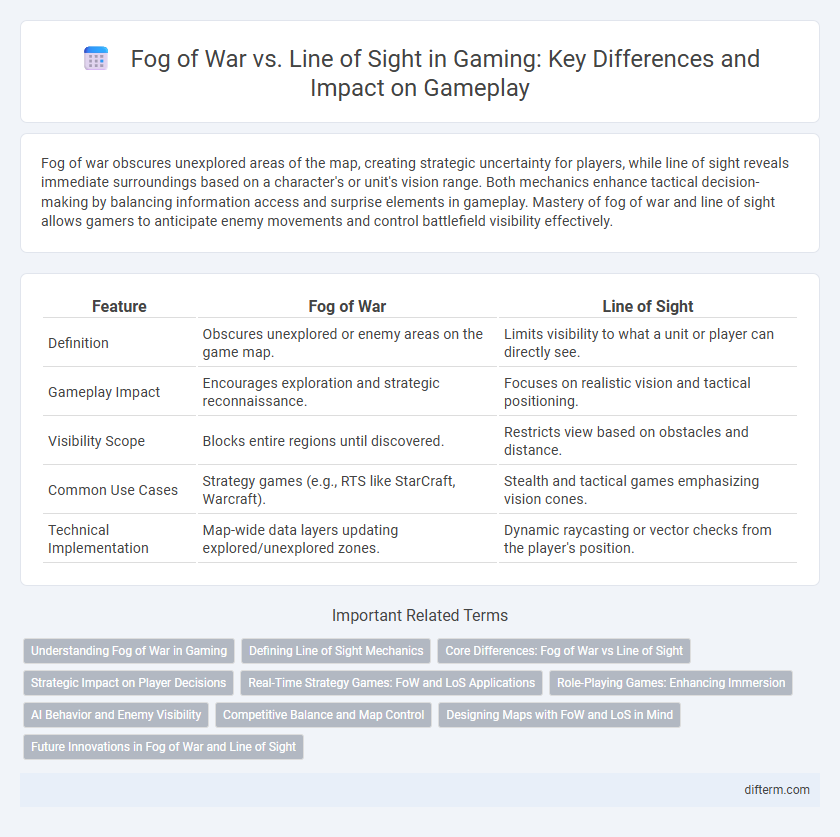Fog of war obscures unexplored areas of the map, creating strategic uncertainty for players, while line of sight reveals immediate surroundings based on a character's or unit's vision range. Both mechanics enhance tactical decision-making by balancing information access and surprise elements in gameplay. Mastery of fog of war and line of sight allows gamers to anticipate enemy movements and control battlefield visibility effectively.
Table of Comparison
| Feature | Fog of War | Line of Sight |
|---|---|---|
| Definition | Obscures unexplored or enemy areas on the game map. | Limits visibility to what a unit or player can directly see. |
| Gameplay Impact | Encourages exploration and strategic reconnaissance. | Focuses on realistic vision and tactical positioning. |
| Visibility Scope | Blocks entire regions until discovered. | Restricts view based on obstacles and distance. |
| Common Use Cases | Strategy games (e.g., RTS like StarCraft, Warcraft). | Stealth and tactical games emphasizing vision cones. |
| Technical Implementation | Map-wide data layers updating explored/unexplored zones. | Dynamic raycasting or vector checks from the player's position. |
Understanding Fog of War in Gaming
Fog of War in gaming strategically obscures unexplored or hidden areas of the map, limiting player vision to enhance suspense and tactical decision-making. Unlike Line of Sight, which restricts visibility based on a character's direct viewpoint and obstacles, Fog of War conceals entire regions until players explore or gain intelligence through units or abilities. This mechanic deepens gameplay complexity by encouraging exploration, reconnaissance, and anticipation of enemy movements within dynamic environments.
Defining Line of Sight Mechanics
Line of Sight (LoS) mechanics in gaming determine what a player character or unit can visually detect within the environment, factoring in obstacles such as walls, terrain, and other objects that block vision. Unlike Fog of War, which hides unexplored or enemy-controlled areas on the map, LoS provides real-time visibility based on the player's or unit's current position and direction. Implementing precise LoS algorithms enhances strategic gameplay by requiring players to consider positioning, vision blocking elements, and the range of unit sight capabilities.
Core Differences: Fog of War vs Line of Sight
Fog of War obscures unexplored or previously seen areas, hiding enemy units and terrain until revisited, while Line of Sight restricts visibility based solely on a unit's current viewing range and obstacles. Fog of War impacts strategic decision-making by maintaining uncertainty over large map sections, whereas Line of Sight enforces tactical awareness through immediate visual limitations. These core differences influence gameplay by balancing exploration with real-time threat assessment in strategy games.
Strategic Impact on Player Decisions
Fog of war limits a player's knowledge of enemy positions outside of explored areas, creating uncertainty that necessitates cautious advancement and strategic scouting. Line of sight restricts visibility based on obstacles and terrain, emphasizing tactical positioning and control of vantage points to maximize battlefield awareness. Both mechanics shape player decisions by balancing risk and information, driving choices that impact resource allocation and engagement timing.
Real-Time Strategy Games: FoW and LoS Applications
In Real-Time Strategy Games, Fog of War (FoW) obscures unexplored or enemy-controlled areas, limiting player vision to regions previously scouted or currently visible, enhancing strategic uncertainty. Line of Sight (LoS) defines the actual visible area from a unit's perspective, dynamically updating as units move, directly influencing tactical decisions and engagement opportunities. Integrating FoW and LoS mechanics creates immersive gameplay by balancing exploration, ambush tactics, and resource management.
Role-Playing Games: Enhancing Immersion
Fog of war and line of sight mechanics dramatically enhance immersion in role-playing games by limiting player knowledge to what their characters can perceive, creating suspense and strategic depth. Fog of war obscures unexplored or out-of-range areas on the map, while line of sight restricts visibility based on environmental obstacles and character positioning. Together, these elements simulate realistic exploration and tactical decision-making, enriching gameplay and narrative engagement.
AI Behavior and Enemy Visibility
Fog of war limits AI behavior by obscuring enemy locations until they enter a player's visible area, creating dynamic uncertainty and forcing strategic exploration. Line of sight directly influences enemy visibility, allowing AI to react in real-time to player's position changes within their visual range. Both mechanics shape AI decision-making processes by controlling how and when enemies can detect and engage the player.
Competitive Balance and Map Control
Fog of war and line of sight mechanics play pivotal roles in competitive balance by limiting player vision and encouraging strategic map control. Fog of war conceals unexplored or enemy-controlled areas, forcing players to gather intelligence and anticipate movements, while line of sight governs what units or structures are visible based on terrain and positioning. Mastery over these elements creates opportunities for ambushes, territorial dominance, and tactical decision-making, directly impacting control of key map objectives and overall game outcomes.
Designing Maps with FoW and LoS in Mind
Designing maps with Fog of War (FoW) and Line of Sight (LoS) requires careful consideration of visibility mechanics to create dynamic player experiences. Strategic placement of terrain, obstacles, and elevation changes enhances FoW functionality by realistically limiting what players can see, while LoS relies on clear sightlines to balance concealment and exposure. Optimizing these elements fosters tactical depth, encouraging players to use reconnaissance and positioning to gain advantages.
Future Innovations in Fog of War and Line of Sight
Future innovations in fog of war and line of sight in gaming harness advancements in artificial intelligence and real-time ray tracing to create more immersive and dynamic environments. Procedural generation techniques combined with machine learning allow fog of war to adapt intelligently to player strategies and environmental changes. Enhanced line of sight algorithms increase realism by simulating complex lighting and shadow interactions, significantly improving tactical decision-making and player experience.
fog of war vs line of sight Infographic

 difterm.com
difterm.com